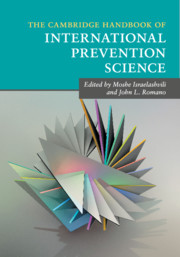Book contents
- The Cambridge Handbook of International Prevention Science
- The Cambridge Handbook of International Prevention Science
- Copyright page
- Dedication
- Contents
- Figures
- Tables
- Contributors
- Foreword
- Acknowledgments
- The Nature of Prevention Science
- Part I The Essence of Prevention Science
- Foundations
- Methodology
- Implementation
- 10 Prevention in Recreational Nightlife
- 11 Preventing Distress and Promoting Psychological Well-Being in Uncertain Times through Career Management Intervention
- 12 Family-Based Prevention
- 13 Preventing Violence and Victimization among Racial/Ethnic Minority and Immigrant Youth in the United States
- 14 Early Intervention to Prevent Lifelong Consequences of Childhood Antisocial Behavior and Social Exclusion
- 15 Comprehensive School Counseling Programs
- 16 Prevention in Early Childhood
- 17 Prevention of Academic, Cultural, and Behavioral Problems among International Student Populations
- 18 Prevention of Adolescent Risk Behavior and Promotion of Positive Youth Development
- Expansion
- Part II The Globalization of Prevention Science
- Index
- References
10 - Prevention in Recreational Nightlife
from Implementation
Published online by Cambridge University Press: 21 January 2017
- The Cambridge Handbook of International Prevention Science
- The Cambridge Handbook of International Prevention Science
- Copyright page
- Dedication
- Contents
- Figures
- Tables
- Contributors
- Foreword
- Acknowledgments
- The Nature of Prevention Science
- Part I The Essence of Prevention Science
- Foundations
- Methodology
- Implementation
- 10 Prevention in Recreational Nightlife
- 11 Preventing Distress and Promoting Psychological Well-Being in Uncertain Times through Career Management Intervention
- 12 Family-Based Prevention
- 13 Preventing Violence and Victimization among Racial/Ethnic Minority and Immigrant Youth in the United States
- 14 Early Intervention to Prevent Lifelong Consequences of Childhood Antisocial Behavior and Social Exclusion
- 15 Comprehensive School Counseling Programs
- 16 Prevention in Early Childhood
- 17 Prevention of Academic, Cultural, and Behavioral Problems among International Student Populations
- 18 Prevention of Adolescent Risk Behavior and Promotion of Positive Youth Development
- Expansion
- Part II The Globalization of Prevention Science
- Index
- References
- Type
- Chapter
- Information
- The Cambridge Handbook of International Prevention Science , pp. 207 - 232Publisher: Cambridge University PressPrint publication year: 2016



